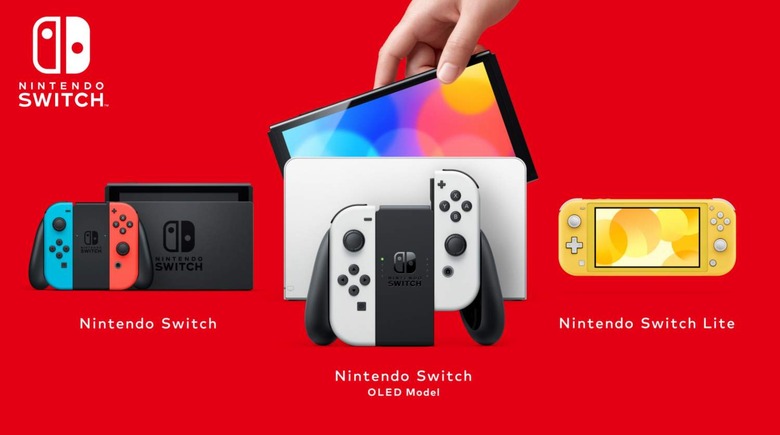Switch OLED Should Be The New Standard
Earlier this week, Nintendo announced the Switch OLED, and it's safe to say that it's not what people were expecting. After years of rumors, most people were expecting Nintendo to announce the Switch Pro, a souped-up Switch with a more powerful CPU that could play games better than the standard Switch. Even though some of its upgrades might sound good, the Switch OLED is decidedly not that Switch.
Nintendo itself has confirmed that the Switch OLED uses the same CPU and RAM as the standard Switch, meaning it won't run games any better than the standard Switch already does. However, it has an OLED display that's a little bit bigger than the LCD on the standard Switch, more internal storage (64GB instead of 32GB), a redesigned kickstand that should be more sturdy when using the Switch in tabletop mode, and other features like a built-in LAN port on the dock and improved onboard speakers.
In short: the Switch OLED is different from the standard Switch, but not in any way that really, truly matters. Going from a 6.2-inch LCD to a 7-inch OLED display is definitely a nice upgrade, but when the Switch's target resolution in handheld mode stays the same at 720p, it's hardly essential. The rest is nice, but they're not exactly Earth-shaking updates.
The Switch OLED is basically a standard Switch but with some more compelling features. It's so much like the standard Switch that it begs the question: is it really worth a separate SKU to add a handful of features that collectively don't offer a huge step up over what's already available? For most existing Switch owners, it's not going to be worth upgrading to the Switch OLED, though I can see someone with an early-model Switch deciding to upgrade to get that OLED display along with vastly improved battery life.
If it's not worth upgrading for most current Switch owners, then that means the Switch OLED is primarily targeted at those who don't have a Switch yet or those who have maybe been on the fence about buying a hybrid console from 2017 years into its lifecycle. Switch OLED feels like a fresh coat of paint for the standard Switch, so to me, it seems like it would be much better for Nintendo to offer the Switch OLED and the Switch Lite moving forward while phasing out the standard Switch.
It just feels like the standard Switch doesn't really have a reason to exist anymore. If I were coming to the Switch for the first time right now and I could get a standard Switch with an LCD surrounded by chunky bezels for $300 or a Switch with an OLED display and slimmer bezels for $50 more, I would get the Switch OLED no question. I wouldn't be surprised to learn that the only reason the Switch OLED is priced at $350 is because the standard Switch is already at the $300 price point; were Nintendo to phase out the standard Switch, I bet it could make the Switch OLED work at $300 given the age of the consoles's other components.

Obviously, I don't work at Nintendo, so I'm not privy to that information or the decision-making process behind offering the Switch OLED and the standard Switch side-by-side. Still, I know that Nintendo's product families can often get to the point where there are so many devices that it risks confusing mainstream consumers. One only needs to look at the 3DS line to see that, because there we saw multiple products all sharing variants of the same name – 3DS, 3DS XL, New 3DS, New 3DS XL, 2DS, and 2DS XL – without clear distinctions between several of them.
When it comes to the Switch and the Switch Lite, one can argue that each fills a clear niche and has a reason for existing. With Switch vs. Switch OLED, on the other hand, I have to say that I don't really see a good reason for the standard Switch hanging around. In my opinion, the Switch OLED should be a replacement for the standard Switch rather than an alternative to it.
You could argue that the Switch already has stiff competition at $300 thanks to the Xbox Series S, while the $350 Switch OLED gets dangerously close to the PS5 Digital Edition's $400 price point, but I don't think that matters all too much to Nintendo's fans. If it did, then the Switch wouldn't have gained any footing when it first introduced because the Xbox One and PS4 were already notably more powerful than it and were priced similarly. Instead, the Switch is barreling toward 100 million lifetime sales and seems unstoppable.
At the end of the day, Nintendo marches to the beat of its own drum and doesn't always do what you'd expect it to. However, I think that Nintendo is missing an opportunity to keep its Switch product line straightforward, and that's something the company has struggled with in the past. For now, at least, the Switch OLED and the standard Switch will co-exist alongside each other even though there may not be a clear reason for that.
